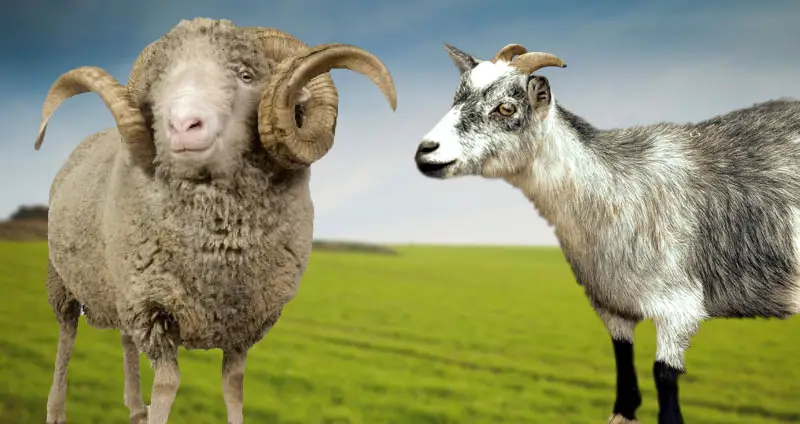It’s not that difficult to differentiate between goats and rams. They’re both farm animals that have been domesticated by humans for thousands of years. But, they come from two different species. Goats belong to the genus ‘Capra’. Rams belong to the genus ‘Ovis’.
One fun fact about rams and goats is that they have rectangular pupils. These amazing pupils allow them to see everything within a range of 300 to 360 degrees without moving their heads. It’s a unique feature, especially when you compare it with our field of vision, which ranges between 160 and 210 degrees.
Contrary to rams, goats are social creatures. They’re also intelligent and curious. Did you know that goats can be taught their names, and to come when called?
More interesting facts about goats vs rams in the following sections.
Table of Contents
The Difference Between Goats and Rams
To begin, let’s talk about their names.
Rams are male sheep. A female sheep is known as a ewe (pronounced you). Baby sheep are called lambs.
The term ‘goat’ can refer to the male or female. But when talking more specifically, ‘billy’ or ‘buck’ refer male goats, ‘nannies’ or ‘does’ are female goats, and ‘kids’ are baby goats.
Now that we know their names, let’s jump in and find out more about these friendly mammals.
Appearance
At first glance, rams and goats have a lot of similarities. However, there are many different physical traits that differ between them.
Some of these differences are very obvious, while others wouldn only be known by people with a lot of experience with both of them.
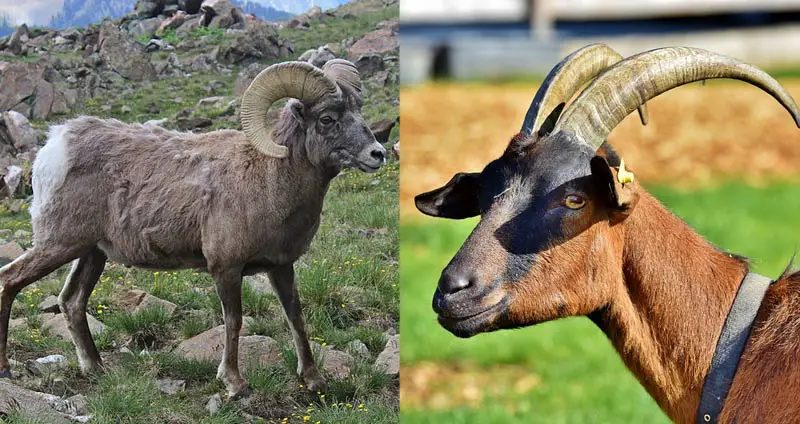
Goats
You probably know that goats are a type of livestock covered with hair. But did you know that they have two layers of hair covering their bodies? The outer layer is rough and a bit long. The inner layer is softer and consists of down fibers. It protects them from the cold.
Goats have hooves that have evenly-spaced out toes. Goats have relatively short horns, with the females having the shortest. Sometimes they’re so short, they’re barely visible.
It’s an interesting fact that both the females and the males are known for their beards, while rams don’t.
They also have short tails that point upwards. It’s only when they’re sick, distressed, or frightened that their tails turn downwards.
There are nearly 200 breeds of goats so their sizes vary a great deal. On average, mountain goats can weigh from 125 to 180 lbs (57 – 82 kg)
Goats have a longer lifespan than rams. They can live up to 18 years if properly cared for.
Rams
Rams are also livestock that’s mostly known for their woolly fur covering. Rams are the breed of sheep that have horns. They’re also even-toed mammals.
They also have tails that are a bit longer than goats and bend downwards. Their tails are covered with wool and are shortened, or docked, for health and sanitary reasons.
This is because their tails are close to their fecal disposal area, where their wastes can cling, resulting in bacteria and parasitic buildup. Docking their tails helps prevent these serious health issues.
Another distinctive feature found in sheep, and is absent in goats, is their upper lip which looks like it’s divided. This division is called a philtrum.
Rams have longer horns than goats. They’re also rounder and curve further back. Rams tend to be bigger in size than goats, as well as heavier in weight. Adult rams can weigh an average of 80 – 400 lbs (35 – 180 kg).
Rams have an average lifespan of 10 – 12 years.
Habitat
The natural habitats of goats and rams are different but do have some overlap. However, they have been kept domestically all over the world, often in the same areas.
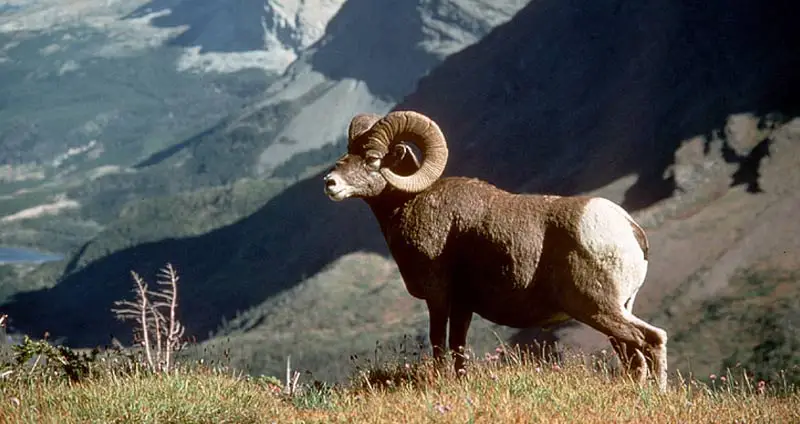
Goats
Goats can be found in most parts of the world where there are meadows, woodland, farmland, and grasslands. Their hooves allow them to easily climb up hills and steep terrains. Mountain goats live in high elevations, usually in the Rocky Mountains in the United States, as well as other mountain ranges in various other countries.
Rams
Rams are found in areas where there are large areas of grasslands. The major national producers of sheep, in general, are the United Kingdom, the United States, Australia, New Zealand, India, China, South Africa, Turkey, and Argentina.
Diet
Goats and sheep are both called small ruminants. Ruminants are a group of animals, which include antelopes, deer, and giraffes, and many others.
They have four stomachs and are able to regurgitate the cud and re-chew it. It’s a distinctive feature that helps them digest their food over a long period of time. This happens with the help of using bacteria and microbial actions to break down the cellulose in their food and use it for energy.
One of their best-known features is that they’re not picky eaters. They’ll graze on anything they can find. They’re not actually grazers, but rather browsers.
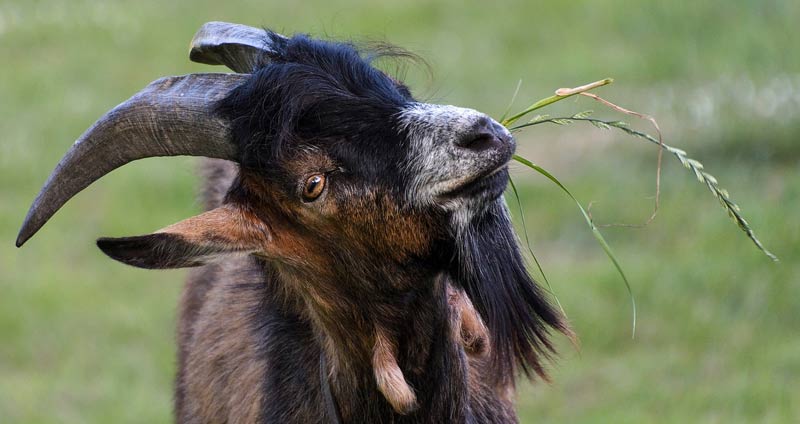
Goats
Their diet mostly consists of leaves, shrubs, vines, most types of plants.
It’s amazing how agile goats can be. They have no problem getting up on rocks or logs to reach leaves on trees or high shrubs. They can even stand on their hind legs to reach vegetation.
They’ll also eat leftover food people have left behind, as well as the container it was left in.
Rams
Rams prefer to graze close to the surface of the soil. They mainly feed on grass, legumes, and clover more than anything else. One of their favorite food is broadleaf weeds or forbs. They also feed on hay, which is where they get most of their minerals.
Behavior
This wouldn’t be known unless you’ve had decent exposure to both of these animals, but they’re actually quite different in terms of their behaviors.
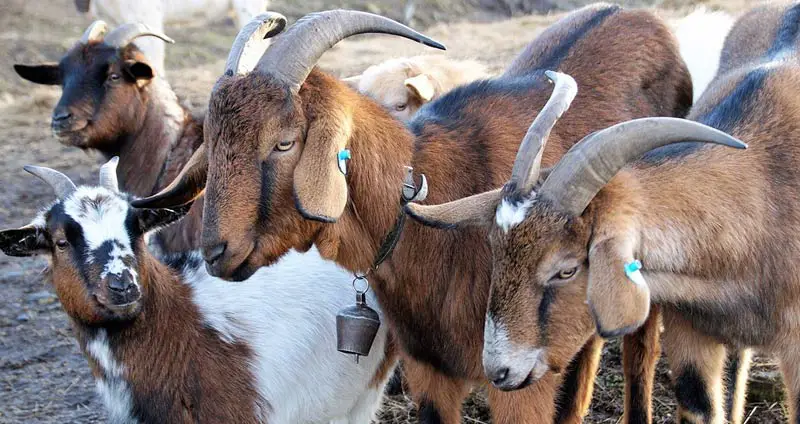
Goats
Goats are more independent and adventurous. They’re also more intelligent and curious than rams. Goats, in general, are more willing to interact with humans. They have a playful and engaging side to them.
Because of their browsing nature when it comes to feeding, goats have a more investigative nature. They have an inquisitive nature, and like venturing out to new areas to explore.
Goats don’t like to get their feet wet. They don’t like being fenced in. but they seek shelter more readily than rams. When confronted, goats stand on their hind legs then come down and butt with their heads. Some can jump up to 12 feet (3.5 meters).
Rams
Rams tend to be more social and tend to stick with their flock. They don’t like wandering off on their own. In fact, they get agitated if they find themselves away from their group.
Rams are easier to handle and have no problem being fenced in, as long as they’re with their flock. They prefer grazing in uplands rather than lowlands.
If agitated, rams back up then charge with their heads.
Uses
Both of these creatures have been used extensively throughout history and continue to be used to this day.

Goats
We’ve been domesticating goats for since the early years of human civilization. People have been using them for their milk, meat, and fiber.
They’re generally classified according to their uses. There are small and large breeds used for milk, small and large breeds used for their meat, and small and large breeds used for fiber.
Rams
Rams aren’t exactly famous sources of meat. However, sheep, in general, are known to be somewhat a good source of meat. What rams are really famous for is their wool. It’s the perfect material for making fine-quality clothes and fabrics.
Conclusion
It’s fun comparing goats vs rams. They’re cute. Plus, we benefit from them in many ways. Did you know that both of these animals contribute to the well-being of our ecosystem?
You may never have any direct contact with them or their by-products. Nonetheless, you can be sure that they have a direct effect on your life, in one way or another.

